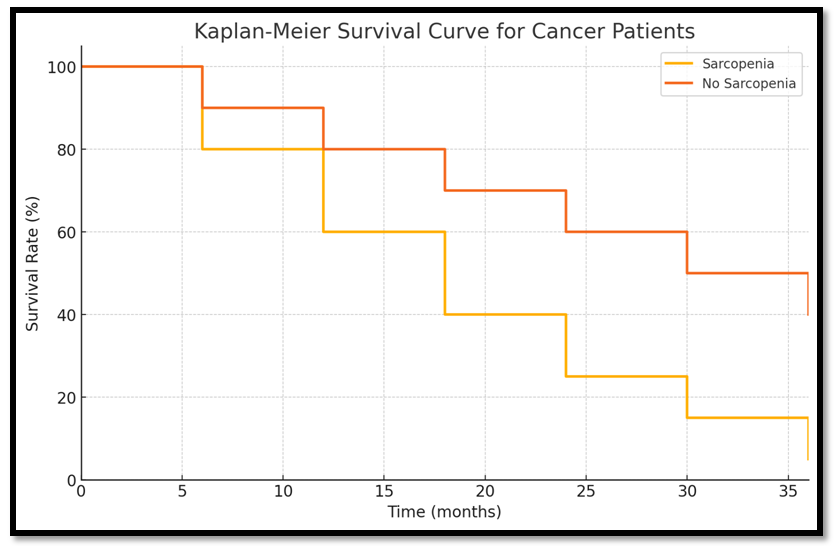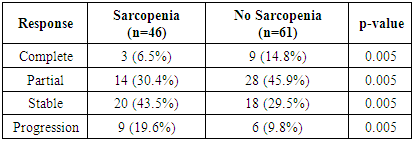-
Paper Information
- Next Paper
- Previous Paper
- Paper Submission
-
Journal Information
- About This Journal
- Editorial Board
- Current Issue
- Archive
- Author Guidelines
- Contact Us
American Journal of Medicine and Medical Sciences
p-ISSN: 2165-901X e-ISSN: 2165-9036
2025; 15(7): 2247-2249
doi:10.5923/j.ajmms.20251507.33
Received: May 20, 2025; Accepted: Jun. 17, 2025; Published: Jul. 11, 2025

Association of Sarcopenia with Response to Chemotherapy and Survival in Cancer Patients
Rakhimov Nodir Makhammatkulovich1, Shakhanova Shakhnоza Shavkatovna2
1DSc., Professor, Department of Oncology, Samarkand State Medical University, Samarkand , Uzbekistan
2PhD., Associate Professor, Department of Oncology, Samarkand State Medical University, Samarkand, Uzbekistan
Copyright © 2025 The Author(s). Published by Scientific & Academic Publishing.
This work is licensed under the Creative Commons Attribution International License (CC BY).
http://creativecommons.org/licenses/by/4.0/

This article investigates the relationship between sarcopenia, chemotherapy response, and survival outcomes in cancer patients. Sarcopenia, characterized by reduced skeletal muscle mass and strength, significantly affects chemotherapy efficacy and patient survival. A comprehensive literature review, clinical findings, and analysis of 107 patients undergoing chemotherapy at Samarkand State Medical University revealed sarcopenia as a critical prognostic factor. Sarcopenia negatively correlated with chemotherapy response and survival, highlighting the importance of early identification and intervention to optimize treatment outcomes.
Keywords: Sarcopenia, Chemotherapy, Cancer, Survival, Bioimpedance Analysis, Computed Tomography
Cite this paper: Rakhimov Nodir Makhammatkulovich, Shakhanova Shakhnоza Shavkatovna, Association of Sarcopenia with Response to Chemotherapy and Survival in Cancer Patients, American Journal of Medicine and Medical Sciences, Vol. 15 No. 7, 2025, pp. 2247-2249. doi: 10.5923/j.ajmms.20251507.33.
1. Introduction
- Cancer cachexia, an irreversible and multifactorial syndrome, encompasses ongoing loss of skeletal muscle mass, with or without loss of fat mass, and is accompanied by anorexia, fatigue, and weakness [3,4]. Cancer-induced muscle wasting is a hallmark of aggressive and end-stage malignancy and accounts for a significant amount of morbidity and mortality in patients with advanced cancer, impacting chemotherapy efficacy and treatment response [1,7]. Due to treatment toxicity and the impact of chemotherapy on sarcopenia pre-treatment body composition assessment may be crucial to optimization of chemotherapeutic management and dosing of drugs, but data on this remain limited. Although there has been increasing interest in the presence of sarcopenia in different kinds of cancer, its correlations with the response to treatment and survival have only been investigated by a limited number of studies in metastatic colorectal cancer (CRC) [2,5]. In CRC, the initiation and advancement of malignancy are closely associated with the presence of metabolic syndrome and abnormalities such as insulin resistance and type II diabetes, suggesting a potential association between metabolic abnormalities and sarcopenia in patients with metastatic CRC [6,10]. Sarcopenia, defined as progressive loss of skeletal muscle mass and strength, significantly impacts the prognosis and treatment efficacy in cancer patients. This condition exacerbates chemotherapy toxicity, reduces treatment tolerability, and negatively influences survival outcomes. Understanding the mechanisms linking sarcopenia to cancer treatment outcomes is essential for optimizing patient care [8,11].
2. Materials and Methods
- We conducted a prospective cohort study involving 107 cancer patients at Samarkand State Medical University between January 2022 and December 2023. Participants underwent chemotherapy and comprehensive sarcopenia assessment via bioimpedance analysis (BIA) and computed tomography (CT). Chemotherapy response was evaluated using Response Evaluation Criteria in Solid Tumors (RECIST), and overall survival (OS) was analyzed through Kaplan-Meier curves. Results Among 107 patients, sarcopenia was identified in 43% (46 patients). A significant association was observed between sarcopenia and chemotherapy response, with sarcopenic patients showing reduced complete and partial response rates compared to non-sarcopenic counterparts (p=0.005). Sarcopenic patients exhibited lower median OS (14.2 months) compared to non-sarcopenic patients (22.5 months; p<0.001).
|
|
3. Discussion
- Our study reinforces previous findings linking sarcopenia to poorer chemotherapy response and survival outcomes. Sarcopenic patients demonstrated reduced treatment effectiveness, highlighting the necessity for targeted interventions such as nutritional support and physical rehabilitation to improve clinical outcomes. The significantly lower response rates among sarcopenic patients (Table 2) indicate that sarcopenia may impair the pharmacokinetics of chemotherapy drugs, exacerbating toxicity and reducing treatment efficacy. Furthermore, sarcopenia was an independent risk factor for reduced survival, emphasizing its prognostic importance.
 | Figure 1. Kaplan-Meier survival curve for patients with sarcopenia and without sarcopenia |
4. Conclusions
- This prospective cohort study demonstrates that sarcopenia is a highly prevalent and clinically significant condition among cancer patients, affecting 43% of the studied cohort. Sarcopenia was independently associated with poorer responses to chemotherapy and significantly reduced overall survival. Patients with sarcopenia showed lower rates of complete and partial responses to treatment and experienced a markedly decreased median overall survival (14.2 months) compared to patients without sarcopenia (22.5 months). The Kaplan-Meier analysis further confirmed that survival rates declined more steeply in sarcopenic patients, with significant differences emerging within the first two years of follow-up.These findings highlight the prognostic value of sarcopenia in oncology and underscore the importance of routine screening for muscle mass and strength in cancer patients. Early identification and comprehensive management of sarcopenia—including nutritional interventions and physical rehabilitation—should be integrated into standard oncological care to optimize treatment efficacy and improve survival outcomes.Future research should focus on developing targeted therapeutic strategies for sarcopenic patients and investigating the potential for individualized chemotherapy dosing to mitigate adverse outcomes. Incorporating sarcopenia assessment into routine cancer management protocols could enhance patient care and ultimately lead to better clinical results.
 Abstract
Abstract Reference
Reference Full-Text PDF
Full-Text PDF Full-text HTML
Full-text HTML
